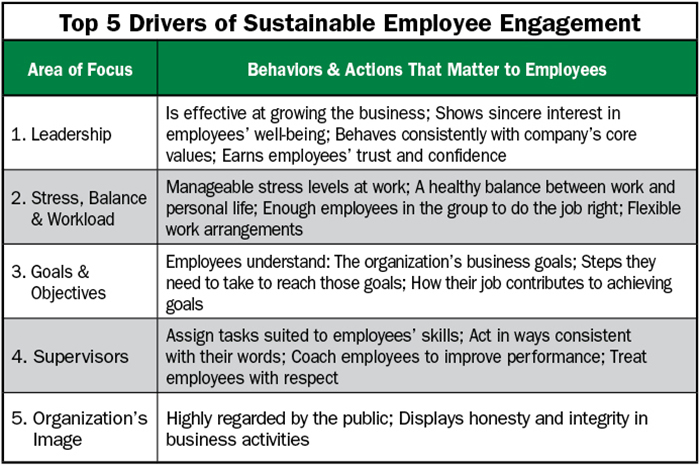In Part 1, we defined employee engagement as going the extra mile. Companies whose employees are highly engaged produce 300% better financial results, according to Towers Watson’s 2012 Global Workforce Study.
“Highly engaged” employees means they are: 1. Engaged traditionally; 2. Enabled; and 3. Feeling energized. This portion of people represents over 35% of employees in a typical company. In Part 2, we’re examining what you can do to move the other 65% (22% unsupported, 17% detached and 26% of disengaged).
The best opportunity to increase engagement is to focus on the 22% of unsupported employees. These are people who already are connected to the organization but are missing some things that will cause them to be more enabled or more energetic. Some examples include providing them greater autonomy, involving them in setting their own schedules and managing their work, encouraging them to take some risks and trying new things, and getting help and direction from their manager.
These kinds of changes don’t involve a lot of new practices. But they are often a matter of strengthening existing policies and practices between the manager and employee to provide the positive energy employees are seeking.
Detached and disengaged employees are more difficult and understanding what drives engagement will help you to increase their engagement.
By focusing on what matters to employees, your dealership can create change, often without spending a lot. A tough market environment where expenses are tight, resources are limited and stress is high does not necessarily mean a negative work environment.
At this time in the market, leadership is vital (Focus #1) and workforce planning is important to match the required work to employees’ skills and experience to reduce stress and increase productivity (Focus #2). The chart below explains what you can do and how you can behave that will matter to your employees in these areas of focus.
Focus areas #3 and #4 directly link the managers to the employees. When it comes to making employees feel more enabled and energized, few things have as much impact as an effective relationship with one’s direct manager.
You should coach your managers to:
- Train them to discuss the link between your company’s business goals and the employee’s personal objectives and ability to contribute.
- Cascade the right information from the top that shares long-term goals and annual plan targets.
- Be clear and transparent when communicating goals and results — promote a team feeling and shared accountability.
- Realize how you achieve results is as vital as the what. State and demonstrate personally the skills and behaviors needed to meet strategic goals and how the employee is responsible to attain those skills and behaviors.
A surprise to many is the extent to which a company’s image contributes to sustainable engagement. A company with a good image signals stability and security to help retain employees. It reinforces the sense of personal pride that is part of traditional engagement.
The Global Workforce Study is directly relevant to your dealership. This summarizes it well: “It’s essential for organizations and their leaders to have a clear understanding of what matters to employees, and why and how that affects their productivity and behavior on the job.”









Post a comment
Report Abusive Comment